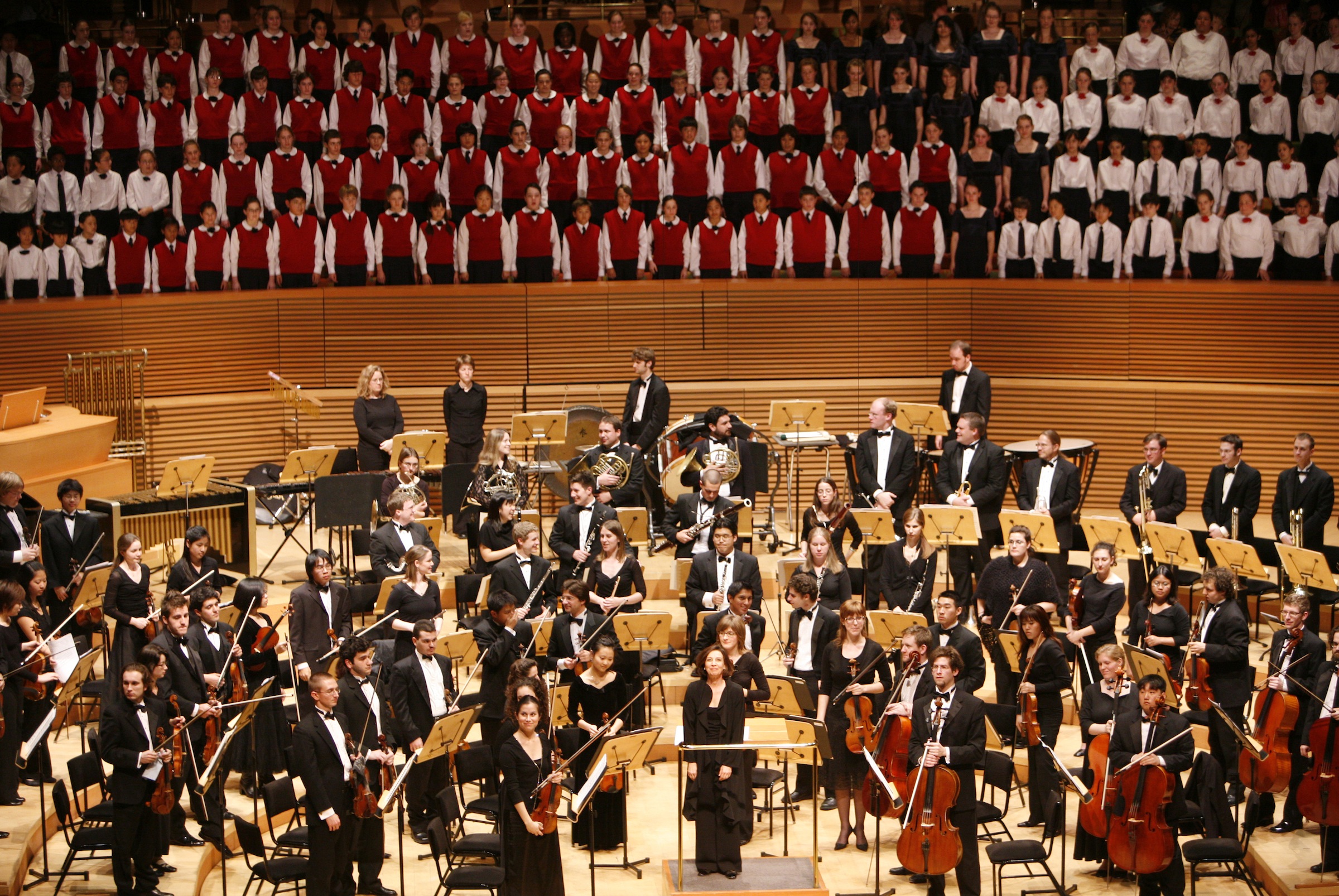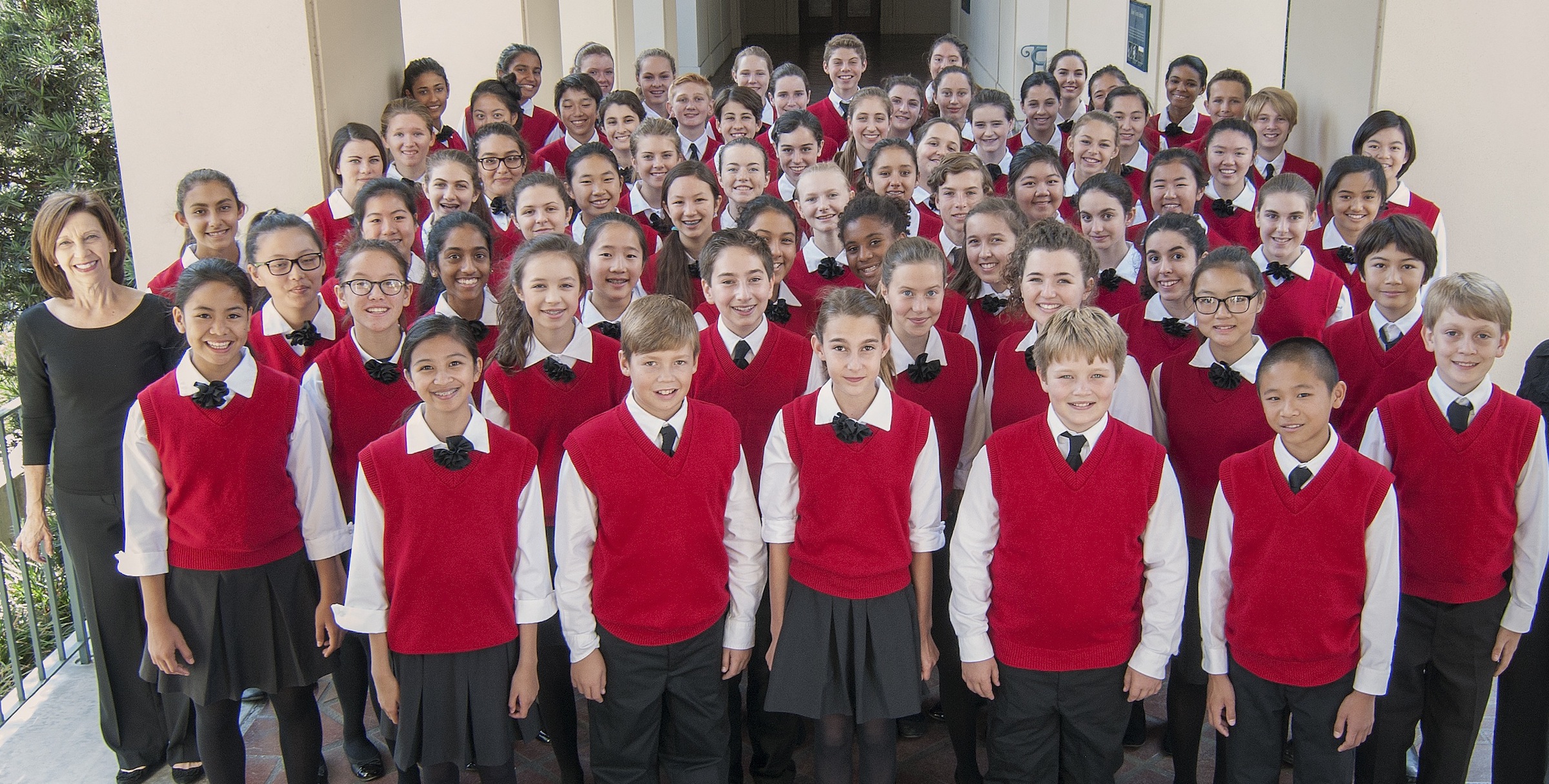voices of angels
Anne Tomlinson (photo: LACC)
“LACC seeks excellence through a rigorous, joyous, nurturing and educational environment.”
Anne Tomlinson has distinguished herself as Artistic Director of the Los Angeles Children’s Chorus (LACC) for almost twenty-two years, and will be relinquishing her position with this group at the conclusion of the 2017-2018 season. Her skills as both choral conductor and musical innovator invite international acclaim as do LACC’s performances locally and internationally. Under her leadership, the group’s active concert schedule includes performances in the US, China, South America, Africa, Australia, Europe and Cuba. LACC is also a frequent collaborator with the LA Opera, Los Angeles Philharmonic, Los Angeles Master Chorale – and works with prestigious conductors such as Gustavo Dudamel, James Conlon, Esa-Pekka Salonen, Marin Alsop and Placido Domingo.
LACC’s diverse repertoire includes John Adams’ El Nino, Mahler’s third symphony, Britten’s War Requiem, Op. 66, the US premiere of Salonen’s Dona Nobis Pacem and three world premieres: Tobias Picker’s opera Fantastic Mr. Fox, Christopher Rouse’s Requiem and Peter Ash’s Keepers of the Night. In 2002, LACC received an Academy Award nomination for Sing, a documentary about the group. They are featured on the recordings A Good Understanding (Decca), Placido Domingo’s Amore Infinito (DGG), and in appearances on NPR, BBC Radio and The Tonight Show. Tomlinson is a recipient of the Pasadena Arts Council’s Gold Crown Award for Music Education and under her guidance, LACC received Chorus America’s 2014 Margaret Hills Award for Choral Excellence. Anne Tomlinson spoke with Editor Leonne Lewis about her choristers.
Since 1996, you have served as Artistic Director of the Los Angeles Children’s Chorus, now in its 31st season. What makes the LACC program a standout?
LACC’s distinctive characteristics include its hallmark sound based on bel canto singing technique. This approach gives children access to the upper range of their voice with a free, open sound. Additionally, each child receives individualized instruction to insure vocal health. We also emphasize music literacy in the hopes that children will read music as easily as they read books. Repertoire is also a signature of this program. Children are introduced to smaller works by master composers, folk music from around the world that is sung in native languages and accompanied by native instruments, and the American musical genres of jazz, gospel, spirituals. Occasionally commercial music is also sung. Through this well-developed program, LACC travels the globe to share their passion for singing and have also collaborated with the Los Angeles Philharmonic, LA Opera, Los Angeles Master Chorale, Jacaranda Music, among others. Preparing children to sing repertoire of emotional depth as well as preparing them to succeed in a professional musical context offers LACC chorister’s opportunities for growth and development both professionally and musically.
The LACC program consists of six ensembles, of which the Concert Choir and Chamber Singers are internationally renown, as well as FES or First Experiences in Singing classes. What are some of the musical challenges involved in conducting these groups?
Children come to any piece with open ears and mind. What might sound modern to mature music lovers is common language to younger people. The children sing works by Philip Glass, Christopher Rouse and many other contemporary composers that invite inquiry and exploration. Sequential learning is also paramount and children who are performing John Adams and Esa-Pekka Salonen have spent years securing acute hearing along with reliable vocal technique.
You have worked with many distinguished orchestral and choral conductors. Does the learning curve change for symphonic or operatic repertoire?
The preparation process is determined by the work being performed and its unique challenges. For example, Mahler’s third symphony contains a brief passage for children’s chorus, which lies quite low in the vocal range. Our preparation includes a focus on full resonance in the lower register of the voice to carry over the orchestra, which creates a unique bell-like color. In Beethoven’s ninth symphony, the younger treble voices join the adult ensemble, so our work is to keep the upper register of the voice open, free and warm. One of the most wonderful things about preparing larger works is the ability to interpret the emotional content of the piece as with Benjamin Britten’s War Requiem, which speaks deeply to children. Children love being challenged musically, intellectually and emotionally by masterworks.
THE LACC PROGRAM OFFERS FES CLASSES FOR STUDENTS AGED SIX TO NINE. HOW MANY CONTINUE ON TO THE CONCERT CHOIR?
Over 40% of current Concert Choir members began in our classes for young children, which emphasizes a joy of singing and provides an introduction to vocal production and elements of music literacy that also contain physical movement.
THE LACC PROGRAM DRAWS STUDENTS FROM THE LOS ANGELES AREA. IS THERE A SPECIAL CONNECTION WITH THE COMMUNITY AND ITS DIVERSITY?
LACC strives to speak to and draw a wide, diverse membership and audience. And we treasure our partnerships with major arts presenters and organizations in the city. The chorus currently serves more than four hundred children, ages six to eighteen from fifty communities across Southern California which are divided into six choirs: Concert Choir, Chamber Singers, Young Men’s Ensemble, Intermediate Choir, Apprentice Choir and Preparatory Choir. As mentioned, the program also offers the FES and First Experiences in Choral Singing Ensemble for six to eight year-olds. Choristers early on are introduced to different languages such as Spanish, French, German, Italian, Latin and more as they progress through the program. In addition, LACC offers after-school classes in Pasadena elementary schools, expanding its reach into the community in a meaningful way.
WHAT ARE SOME IMPORTANT GUIDELINES LACC USES WHEN TRAINING CHILDREN OF THE VARIOUS ENSEMBLES?
LACC works to master all aspects of choral artistry. Over a period of years, we introduce young singers to the importance of the breath mechanism and working towards an open, free tone. Repertoire is selected to specifically assist in the developmental process. Balance is taught from a refinement of acute listening, which ensures that the unique colors of harmonic writing are properly expressed. To ensure clear communication, elements of elocution for singers is another main focus. Choristers are reminded that our art is shared and that carrying the music and poetry from page to audience completes our circle of learning. So, LACC introduces children to a full range of choral expression, helping choristers understand and discern authentic musical expression and emotional integrity - from chant to minimalism.
WHEN LACC PERFORMS INTERNATIONALLY, IS THERE A STRONG APPRECIATION FOR CHORAL MUSIC?
LACC has been enthusiastically welcomed around the world and we have found that the love of singing is universal. Audiences everywhere recognize the children’s passion for sharing their lives and hopes through the choral art. We’ve had so many incredible experiences, such as children in China asking for LACC member’s autographs, children in Brazil leaning over balconies to get a closer look and singing with audiences in Soweto, South Africa.
AT THE CONCLUSION OF LACC’S 2017-2018 SEASON YOU WILL BE STEPPING DOWN AS ARTISTIC DIRECTOR. COULD YOU MENTION SOME MEMORABLE PERFORMANCE MOMENTS?
One fun memory featured the staging of rehearsals for Mozart’s The Magic Flute with LA Opera in the Otto Schenk directed production, which required that boys fly thirty feet above the stage in an “Air Ibis” boat. Because rehearsal time on stage was limited, much of the basic blocking was located off stage on the Dorothy Chandler Pavilion’s fourth floor– with these three ‘child-spirits’ getting used to not having their feet on the ground by being placed on chairs inside a garment rack and rolled by stage managers throughout the rehearsals! Musically memorable performances included concerts of Mahler’s eighth symphony, the second of which was held at the Shrine Auditorium as part of Gustavo Dudamel’s complete Mahler symphony cycle. The stage was filled to the brim with the Los Angeles Philharmonic, Simon Bolivar Youth Orchestra and choirs both professional and amateur from across the city. It was a truly remarkable community endeavor. I am incredibly lucky to work with deeply talented and inspiring musicians in so many contexts. www.lachildrenschorus.org



